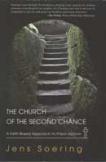What Good Can Come
Prisoners have often written about their lives behind bars, but Jens Soering’s The Church of the Second Chance stands out because it involved considerable research. How, a reader might ask, could a person serving a life sentence for murder, with only limited access to a typewriter and none to computers, produce a book filled with reliable information from respected sources like the National Council on Crime and Delinquency, the American Bar Association and the Vera Institute of Justice? The index provides a guide to these and other respected organizations consulted in the preparation of the book.
The author of three previous books dealing with various aspects of incarceration—one of which won first place among the 2007 Catholic Press Association awards—Soering was fortunate in having skilled outside friends (his “elves,” as he calls them) who did part of the research that lends the book much of its credibility. Other friends helped cover the cost of the professional typing service that produced the manuscript for the publisher. As he himself points out, such assistance is rarely accessible to those behind bars.
A Catholic who speaks of finding strength in centering prayer, Soering makes it clear that whatever the denomination, faith can play an important role in the lives of prisoners struggling with their confinement. Religious themes also find their way into the interviews that form part of the book.
Among the most striking is an interview with Kinda White, whose daughter was raped and killed by two teenagers. An adjunct professor of philosophy, psychology and criminal justice at a university in Texas, Dr. White not only forgave the perpetrators; she was able to move away from the concept of retributive justice that dominates the criminal justice system in the United States. After immersing herself in works like Howard Zehr’s Changing Lenses: A New Focus on Criminal Justice, she opted for restorative justice, a stance that led her to join the anti-death penalty group, Murder Victims’ Families for Reconciliation. She became a member of the board and eventually began speaking publicly about nonviolent alternatives to the death penalty. In the spring of 2001, she arranged to speak with one of the two who had killed her daughter— not the experience of most who have lost a loved one to murder. The interview underscores the author’s and Kinda White’s belief in restorative rather than retributive justice. Soering is careful to acknowledge, though, that some offenders are too dangerous to be anywhere except in confinement.
Prison reform advocates frequently observe that the families of prisoners, too, undergo a punishment of their own. Studies have repeatedly shown that frequent contact with relatives enhances the chances for a prisoner’s successful transition back into the community. But because of the great distances that separate many prisoners from their families, incarcerated men and women rely on the telephone to maintain contact. Unfortunately, as the author explains, exorbitant charges that benefit private companies like M.C.I. create harsh financial burdens for low-income family members. Such telephone charges are but the tip of the iceberg of ways in which purveyors of “services” within the criminal justice system reap huge profits. At the same time, by spending too little money on caring for the estimated 20 percent of the U.S. prison population who are mentally ill, prison systems not only intensify their suffering, but also almost ensure their return to prison after release.
Two-thirds of those who complete their sentences, in fact, whether mentally ill or not, re-offend within three years. The Second Chance Act, signed into law in the spring of 2008, at least offers some hope that the obstacles prisoners face on leaving prison after completing their sentences may finally be receiving needed recognition by Congress. In addition, Soering cites a few programs that do assist in the re-entry process. In his own state of Virginia, where he is serving his sentence, the Depart-ment of Corrections and the federal government jointly operate a re-entry program for high-risk offenders. Six months before release, they receive identification documents—crucially important for obtaining Medicaid and food stamps—as well as help in accessing housing and substance abuse programs. Kansas has a similar state-run program, and one county in Oregon provides re-entry assistance for juvenile offenders in the form of work constructing homes for Habitat for Humanity. But as the author notes, even though we know what to do with respect to restorative justice models of these kinds, “we lack the will to do it”—and also the funding that would make such hopeful initiatives more widely available.
Our extraordinarily long sentences, through measures like mandatory minimums and three-strikes-and-you’re-out laws, stand in marked contrast to sentencing practices in European countries. There, Soering points out, prison terms of “ten to twelve years are deemed very long and twenty years is the outside limit.” Such differences between the U.S. approach to sentencing and, say, that of France and Italy (Mr. Soering quotes an Italian judge as saying, “no one stays twenty years in prison”) may lead readers of this informative, scripturally rooted book to question the viability of our present approach to crime and punishment.
This article also appeared in print, under the headline “What Good Can Come,” in the October 27, 2008, issue.








